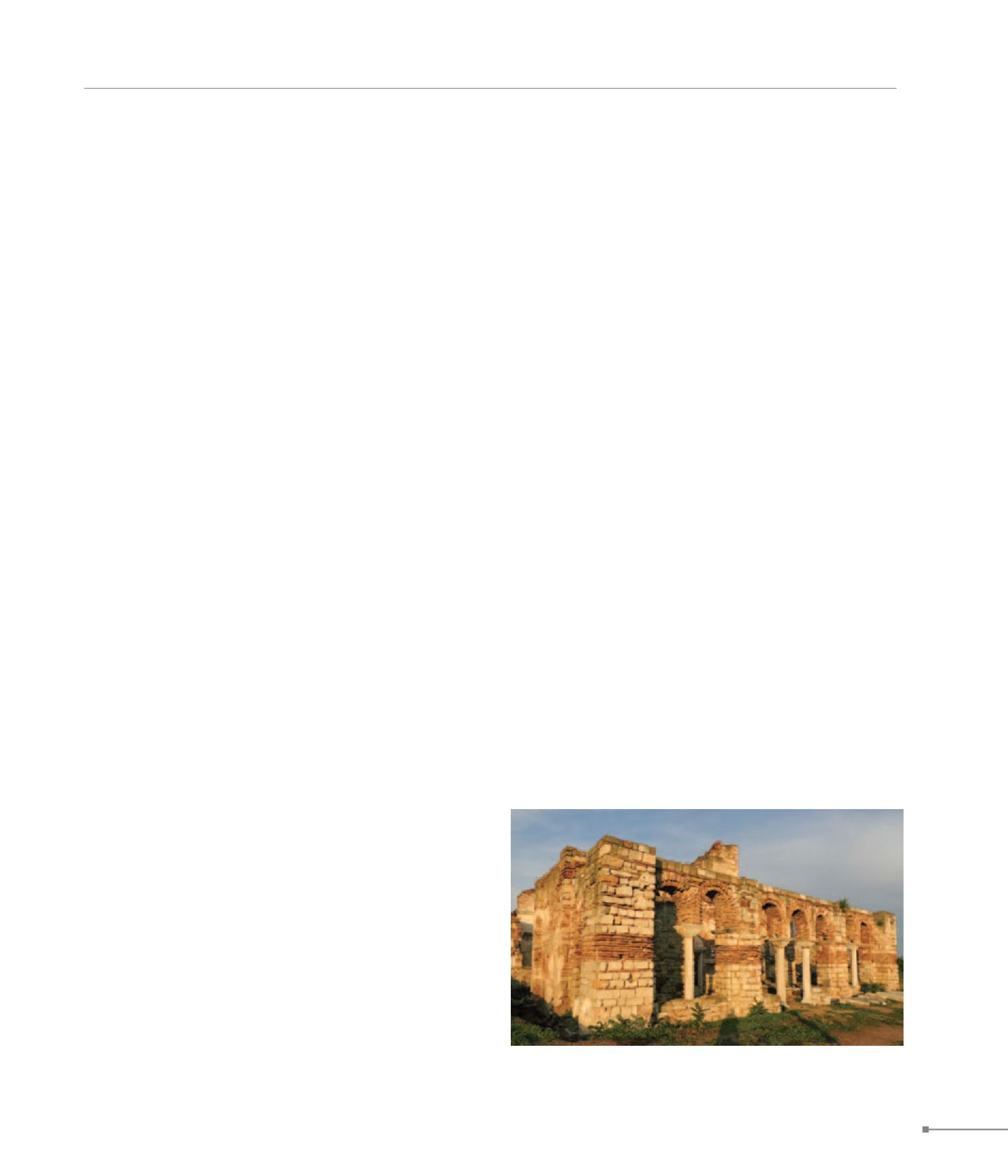
Βehramkale. Assos.
Enez. Ainos.
COASTLINE OF ASIA MINOR AND EASTERN THRACE
307
562. Ainos, Fatih Camii (Αίνος, Fatih Camii)
In the late 7th c., the upper section of the castle was fortified
due to the Arab threat. It was then that the Great Altar of Zeus
was destroyed in order for its material to be used for the for-
tifications. The entire city outside the castle was deserted but
was reinhabited in the Mid-Byzantine period. It was fortified
with new walls to replace those that, up to the 13th c., had
been repeatedly repaired. Few remains of churches survive
from the middle ages. At the theatre stood a small cross-in-
square church of the 13th c., which probably belonged to a
monastery. Ruins of a church of the same type, with a burial
chamber annexed to it, have been detected NW of the sanctu-
ary of Hera. Above the temple of Athena are remnants of a sin-
gle-nave church. Two of the side columns have been moved
to the centre of the ancient temple, probably to support the
dome.
At the Asclepieion, 2 km from the city, a baptistery was built in
the NW corner of the courtyard’s propylon. The baptistery is
likely to have been linked to the church constructed over the
Circular Building (temple of Zeus and Asclepius). Finds on the
Via Recta
,
leading from the city to the Asclepieion attest to the
fact that it was in operation even in the 5th-6th c. The buildings
in the environs of this street are dated up to the 7th-8th c.
Mid-Byzantine sculptures are kept in the Archaeological Mu-
seum of Pergamon.
East Thrace
562.
Enez. Ainos.
A few architectural sculptures from the Early Christian period
are known, dated circa 500. In the Mid-Byzantine and Late
Byzantine period, Ainos reached its peak as indicated by the
remains of churches, with Fatih Camii on the citadel the most
significant. Its original dedication is unknown; the suggest-
ed Aghia Sophia is not certain. It is a large, cross-in-square
church associated with the Constantinopolitan architectural
tradition of the 12th c., but there are particularities that seem to
classify it as Late Byzantine years. It is in a very poor condition
and major sections collapsed soon after 1962 and between
1979 and 1982.
A small, cross-shaped structure with a dome, once known as
Saint Euplius’, of uncertain date, perhaps a martyrium, was
converted into a mausoleum by the Turks (Yunus Baba or
Yunus Bey). In the neighbourhood of Yenimahalle remnants
of a cross-in-square church can be discerned. Excavations
have brought to light parts of another Byzantine church in the
neighbourhood of Kral Kizi. The churches of Saint Nicholas
(1420-1) and of Theotokos Chrysopege (1422-3) are known
from dedicatory inscriptions. The walls of the ancient citadel
were repaired in the middle ages; inscriptions and escutch-
eons of the Gattilusi family, dating from 1382 (or 1385) and
from 1413, still exist. The repairs at the time of Byzantine Em-
peror Justinian I, mentioned by Procopius (
De Aedificiis IV
11.16
), are impossible to detect.
561.
Βehramkale. Assos.
The city prospered in the Early Christian period, as indicat-
ed by the remains of seven or eight basilicas, two of which
have remnants of mosaic floors. The basilica at the site of the
gymnasium features parts of walls and colonnades from the
ancient building. To the small former temple at the agora con-
verted into a church, an apse was added. The famous temple
of Athena at the citadel does not display any alterations indi-
cating that it was converted into a church in the Early Christian
era, though it is certain that it was used in Christian worship.
Some coarsely prepared capitals scattered throughout the
city are made from locally quarried andesite and can be dated
to the 6th c. In the 12th c. (?) the citadel around the temple of
Athena was fortified again.


